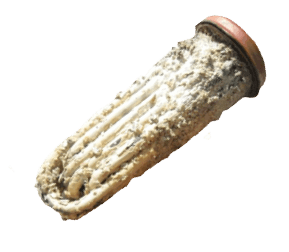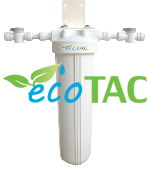Compare Hard Water Treatment Technologies for Water Heaters
learn the most efficient and environmentally-friendly hard water treatment options for tankless and tank-type water heaters
| Learn More About Water Quality & Tankless Water Heaters: | |
|---|---|
Various treatment methods exist to address water hardness and prevent harm to water heaters and other appliances. Each has their own advantages and disadvantages.
Some technologies aim to remove the hard water minerals (capacitive de-ionization, reverse osmosis), some aim to exchange hard water minerals for other, less problematic ions (conventional water softener), some aim to sequester hard water minerals by coating them with a protective chemical layer (polyphosphate/Siliphos), and others aim to physically alter the structure of the hard water minerals to prevent scale formation (TAC, eletronic/magnetic).
| Comparison of Hard Water Treatment Technologies for Water Heaters: | ||||||
|---|---|---|---|---|---|---|
| Technology: | Template Assisted Crystallization Media (TAC) | Conventional Water Softener (Ion Exchange) |
Polyphosphate (Siliphos) | Reverse Osmosis (RO) | Capacitive De-ionization | Electronic / Magnetic |
| Scale Reduction Effectiveness: | Excellent (>90%) | Excellent (>90%) | Fair to Good (depends on flow rate and filter age) | Excellent (>90%) | Excellent (>90%) | Poor (often <50%) |
| Requires Salt Regeneration?: | no | yes | no | no | no | no |
| Water Efficiency: | 100% water efficient | poor, backwash required | 100% water efficient | very poor, constant waste stream during production | poor, backwash required | 100% water efficient |
| Chemicals / Contaminants Added to Water: | none | sodium or potasium (not recommended for drinking water) | polyphosphates | none | none | none |
| Media Replacement: | every 2-3 years | every 2-5 years | every few months | every 2-3 years | depends on feed water conditions | n/a |
| Environmenally Friendly?: | yes, no chemicals added to water, no water waste | no, salt (brine) discharge and water waste in backwash | no, polyphosphate released into environment | no, high water waste during production | moderate, some water waste during self-cleaning process | yes, no chemicals added to water, no water waste (some models use electricity 24/7 though) |
| Relative Size: | small | large | small | large | large | small |
| Relative Maintenance: | low, replace cartridge or media every 2-3 years | high, add salt frequently | moderate, replace cartridge every few months | moderate, replace membrane every 2-3 years, pre-filters every 6 months | depends on feed water conditions | minimal |
| Relative Cost: | low cost | expensive | low cost | units that produce suitable flow/volume are very expensive, not practical for water heater protection | very expensive, not practical for water heater protection | low cost |
| Evaluation: | effective, low cost, environmentally-friendly - recommended treatment technology | not recommended due to high cost, large size, water waste and salt discharge | not recommended due to inconsistent performance, short media life, polyphosphate release | not recommended due to high cost and water waste | not practical due to very high cost | not recommended due to poor scale reduction performance |
Unfortunately, technologies that are designed to actually remove the hard water minerals tend to be impractical for water heater protection due to excessive cost or maintenance requirements, water waste, or other operational reasons. These include capacitive de-ionization (also known as electrically-induced de-ionization) and reverse osmosis. Since these technologies produce water with very low levels of dissolved minerals and ions, the water tends to be quite aggressive which can lead to corrosion problems in a water heater and the plumbing system. These systems also tend to have maintenance-related problems when water hardness exceeds about 7 grains per gallon (GPG) or 120 mg/l (ppm).

heavy hard water mineral build-up on a tankless water heater element |
Due to their high cost, conventional water softeners are usually employed as a whole-house treatment and not specifically for water heater protection. Water softeners remove hard water minerals by exchanging them for sodium (or, rarely, potassium) ions. To maintain performance, they use large volumes of salt to regenerate their media. This process is not considered very environmentally friendly due to the high level of water waste and salt discharge to the environment. Accordingly, conventional water softeners are being banned in many communities. Treatment with traditional water softeners also results in the water having a slippery feel and increased sodium content (which is undesirable for drinking water). They are, however, a well proven scale prevention technology.
Most other hard water treatment systems use polyphosphate crystals (sometimes marketed under the name Siliphos) to sequester the minerals responsible for scale formation. Unfortunately, they release significant volumes of phosphate into our waterways, polluting the environment. They also require frequent filter changes to maintain effectiveness as the polyphosphate gets depleted. Maintenance is often neglected resulting in poor performance.
More recent hard water treatments, often categorized as "physical water treatment", aim to prevent mineral scale by altering the physical attributes of the hard water minerals in a way that makes them unlikely to form mineral scale on surfaces (pipe walls, heating elements, etc.). Electronic and magnetic devices have largely proven ineffective. While they do reduce mineral scale formation, the reduction rates are often not sufficient enough to make a meaningful difference. However, a media referred to as Template Assisted Crystallization (TAC) has proven extremely effective at reducing scale formation. This technology is also sometimes referred to as Nucleation Assisted Crystallization (NAC) as it uses a highly specialized media which provides a preferable nucleation point for the formation of nano-crystals of calcium and magnesium carbonate before the mineral scale reaches your water heater elements. The crystals are stable and remain suspended in the water flow instead of forming hard mineral scale on the surfaces in your plumbing system. We recommended TAC technology as a scale prevention system to protect tankless and tank type water heaters as it is environmentally friendly (as it does not add any chemicals to the water, does not require backwash or re-generation), is affordable, is physically small in size, requires very little maintenance, and is highly effective. Click here to learn more about TAC treatment.
Beware of vendors that don't tell you what technology their filter uses - most often it is an inferior polyphosphate feeder or worse; it could simply be a sediment or activated carbon filter that won't remove or prevent scale formation at all.
We recommend the following hard water scale prevention filters for tankless and tank type water heaters:
6 GPM Hard Water Treatment

for flow rates up to 6 gallons per minute - salt-free, environmentally-friendly filter designed to reduce the harmful effects of hard water on your tankless water heater
Now Only US$329.95
- More Info -
4 GPM Hard Water Treatment

for flow rates up to 4 gallons per minute - salt-free, environmentally-friendly filter designed to reduce the harmful effects of hard water on your tankless water heater
Now Only US$289.95
- More Info -

